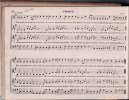- Messages
- 6,808
- Location
- Penrith, Cumbria, UK
As those of you who have known me a while, my handle on here comes from the fact that I play the viola da gamba (aka viol) and I play both tenor and bass. The standard clef for the tenor is 'alto' C3 clef and it goes up to use octave treble G2 clef (sounds octave lower than written). The bass uses bass clef (F4) and alto (C3).
I play cello, which uses bass (F4), tenor (C4), and treble (G2) at pitch.
Saxophones all use treble G2, but are transposed.
I thought you might like this video which gives some of the challenges in understanding early music and use of clefs... which makes you realise a)life is now simpler for most of us, b)if all you play is an instrument that uses one clef, lucky you...
View: https://youtu.be/qBmBuMsiIt0
I play cello, which uses bass (F4), tenor (C4), and treble (G2) at pitch.
Saxophones all use treble G2, but are transposed.
I thought you might like this video which gives some of the challenges in understanding early music and use of clefs... which makes you realise a)life is now simpler for most of us, b)if all you play is an instrument that uses one clef, lucky you...





